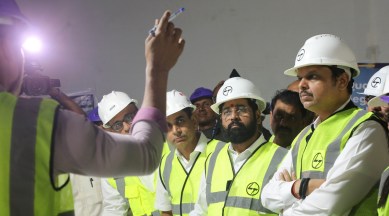Stay updated with the latest - Click here to follow us on Instagram
Mumbai: BMC invites tender for elevated road linking Dahisar to Bhayandar
The new road is expected to reduce traffic snarls at Dahisar check naka of Mumbai and the satellite city of Mira Bhayander.

In what could be a breather to motorists battling the traffic snarls in Dahisar check naka of Mumbai and the satellite city of Mira Bhayander, the Brihanmumbai Municipal Corporation (BMC) Saturday issued tender to build an elevated road linking Dahisar (West) to Bhayandar (West) – the last leg of the coastal road.
At present, it takes nearly 30 minutes for a 5-kilometre journey via the Dahisar check naka, the main road connecting the Mira Bhayandar to the Greater Mumbai Region, apart from Western Express Highway.
monthly limit of free stories.
with an Express account.
The tender, published by the department of bridges, has set a deadline of 42 months, inclusive of monsoon, to finish the project.
The five-kilometre-long elevated road with a width of 45 metres will have a few bridges as well. Ahead of the construction, the contractor will have to get clearance from the state coastal zone management authority, the forest department, and the salt commissioner as the alignment passes through mangroves and Dahisar creek areas, and salt pan lands. The tender also mandates pre-approval from Maharashtra Maritime Board, Mumbai Metropolitan Region Development Authority (MMRDA), and Mira Bhayander Municipal Corporation (MBMC).
MBMC, one of the fastest-growing satellite cities with a population of over 1.50 million, lies in the Mumbai Metropolitan Region (MMR). It is estimated that almost 10 lakh people commute from Mumbai to Mira Bhayander and vice-versa, daily, said BMC officials.
“Once the BMC completes the work of the northern stretch of the coastal road connecting Dahisar and Bhayander, traffic snarls at Dahisar check naka will soon be a thing of the past. It would cut down nearly 70 per cent of the traffic snarls,” BMC officials said.
As per rough estimates, the road will cost the BMC around Rs 1,600 crore and the land acquisition may also cost an equal amount.
Earlier this year, the MMRDA agreed in principle to hand over the Dahisar stretch of the coastal road to the BMC.
The construction of the first phase of the coastal road is progressing at Princess Street and is expected to be completed next year. The second phase starts near the southern end of the Worli Bandra Sealink, while the third phase starts from the northern end of the Sealink and ends at Versova. However, there is not much clarity on the stretch between Versova and Dahisar.
“The economic activity in the Mumbai Metropolitan Region is interconnected with the economic activity in the Greater Mumbai Region, which is controlled by the BMC. As a result, there is a constant and continuous movement of people between the adjoining cities to the Greater Mumbai Municipal corporation area,” said a BMC spokesperson.
At the moment, there are only two modes of connectivity between the Mira Bhayandar Municipal Corporation and the Greater Mumbai Region. The Western Express Highway and Western Railway lines, both serve as the primary connectivity through road and rail respectively, he said.
Hence, traffic jams on Western Express Highway are a routine affair and the local trains are also always crowded, he said.
Based on previous studies, MMR has incorporated the vital coastal link from the western side of Dahisar to Bhaindar in its development plan. Both the local bodies have made suitable provisions in their respective development plans for connectivity. However, due to engineering challenges, the link remained unconstructed, the spokesperson added.
Out of the 5 km of the elevated road, 1.5 km falls in the BMC jurisdiction and 3.5 km in the MBMC jurisdiction. The project is being implemented by BMC with the cooperation of MMRDA.
It will start near Kandarpada Metro station, Link road, Dahisar (West) to Uttan Road, near Subhash Chandra Bose Ground, Bhayander (West).
The elevated road shall be a 4 X 4 lane. It shall be constructed on stilts with emergency lanes on both sides to facilitate the movement of ambulances and emergency vehicles. The road shall have the capacity to handle a traffic volume of 75,000 cars per day.
“Several environmental factors were taken into account in engineering concepts and design so as to minimise environmental damage but provide maximum benefit to citizens,” the spokesperson said.
Longer spans and obligatory spans are designed to minimise mangrove cutting.
He said that signal-free multi-level road interchanges are proposed on both sides to avoid traffic congestion.
“In order to effectively utilise the spaces in between, the project will have multi-level seven-storey mechanised parking lots with a bus terminal at the basement so as to create multi-model transport hub adjoining the Metro station. There shall be 550 parking spaces available for commuters,” he said
The road will be supported by central pillar structures with a height of 100 metres above the waterways within the BMC, the spokesperson said.
In areas where the road makes its way through mangroves, a space needle-type structure with a multi-level deck will serve as a mangrove forest observatory point and nature appreciation centre for students. One can enjoy nature’s beauty and cityscapes from the top viewing point, and it would boost tourism, for sure, he said.
The BMC has worked out a rough net estimate of Rs 2,574 crore. The gross estimated cost is Rs 3,186 crore, including escalation provision, permission charges, and royalties, the BMC spokesperson said.